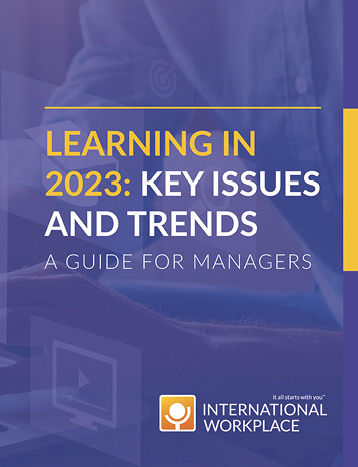Kelly Mansfield of International Workplace presents some of the key findings in International Workplace’s guide for managers, Learning in 2023: Key issues and trends
“The pandemic caused shockwaves, including talent disruption, inflation, skills shortages, and global tension,” advised LinkedIn in its 2023 report, Building the agile future. “But with more companies realising that daunting challenges demand new skills, L&D has never been better positioned to help.”
The world of work is unrecognisable from pre-pandemic days, with styles of work demanding new skills, so upskilling or reskilling will be essential in 2023. As the skills needed in the workplace change, skills attainment must continue.
Respondents to the 2021 Deloitte Global Human Capital Trends survey identified “the ability of their people to adapt, reskill, and assume new roles” as the top-ranked requirement to navigate future disruptions successfully. This includes acquiring not only new skills but as many as 10 per cent more skills year-on-year for a single job.
At the same time, employees must replace old skills with new ones. Over 30 per cent of the skills required three years ago will soon be obsolete, according to Gartner. Today’s employees must be agile and ready to constantly upskill in technical areas as well as in their specific functional roles and will get there through sustained, organisation-wide learning programmes and a culture that supports learning.
REIMAGINING LEARNING
The term ‘hybrid’ is ubiquitous these days – hybrid vehicles, hybrid working and now hybrid learning. The pandemic has made us realise how we can work differently, and the same is true of L&D. “As hybrid work challenges long-held ideas and expectations around engagement, productivity and career development, L&D teams are uniquely positioned to reimagine how organisations tackle today’s toughest challenges and navigate the uncharted waters of tomorrow,” says the Panopto Essential Hybrid Training Playbook. Training managers have the opportunity to develop a strategic culture of hybrid learning. Before crafting a successful training strategy, first you must understand the challenges your employees face when training, learning, and accessing the right information to do their jobs.
Many organisations grappled with unprecedented employee turnover in the wake of the pandemic. While some layoffs have made headlines in recent months, talent development professionals continue to struggle with skills shortages and turnover risk for critical talent.
The main factors that people consider when pursuing new jobs reflect their desire to stretch, grow and develop new skills. But it’s also important to continue to attract existing staff, and providing learning opportunities is the number-one way organisations are working to achieve this.
TRENDS IN LEARNING SKILLS
To acquire the quickly evolving skill sets required for the workplace, employees can’t stop with the specific functions of a given role anymore, says Udemy’s report on workplace trends. “Learners are looking to boost their business capabilities and expand them across broader categories, including soft skills, tech skills and operations. Key business skills matter for every employee, regardless of role or level of seniority.”
Learners are focusing most on communication, underlining the importance of creating alignment, fostering collaboration and teamwork, mitigating conflict and enabling productivity. We’ve seen a growing overlap between personal and professional lives throughout the pandemic. While we call these personal skills, and they do matter for the personal lives of learners, most of these skills really position them for success in the workplace. Skills to help employees manage workplace stress, avoid burnout, and live fuller lives – in or out of the office – are pulling learners in. So are skills that empower them to navigate the workplace more effectively and do their jobs more efficiently.
DATA AND AI
The results of 2023’s L&D Global Sentiment Survey were revealed in February 2023, showing AI and analytics as the number one trend in L&D.
Says Donald Taylor, Chair of the Learning Technologies Conference: “The power of AI and the ability to handle data have grown hugely more sophisticated. ChatGPT is only the latest, public expression of decades of work that have been taking place in the background. Has L&D’s understanding of AI and data kept pace during all this? Or are we destined to play catch up with the powerful technologies that bewitch and bedazzle us?”
We can expect to see the growth of AI and the power of the use of data continue apace this year and beyond. The challenge for L&D is whether it can master it.
CONCLUSION
Those who support learning of essential skills as a foundational element of a stronger, more vibrant culture will see both higher employee engagement and a better-prepared workforce. With a comprehensive, integrated approach to learning that is fine-tuned to the needs of individual teams and learners, organisations will be poised for future growth and well-equipped to handle disruptive change from any source.
“Turns out, robots can’t do everything,” says Dani Johnson, Co-founder and Principal Analyst, RedThread Research. “The pandemic has taught us the importance of the humans that make up an organisation. L&D practitioners are in a unique situation to nurture those humans by meeting one of their fundamental needs – the need to grow and develop.”






